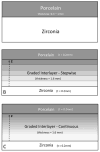The bending stress distribution in bilayered and graded zirconia-based dental ceramics
- PMID: 28104926
- PMCID: PMC5241077
- DOI: 10.1016/j.ceramint.2016.03.245
The bending stress distribution in bilayered and graded zirconia-based dental ceramics
Abstract
The purpose of this study was to evaluate the biaxial flexural stresses in classic bilayered and in graded zirconia-feldspathic porcelain composites. A finite element method and an analytical model were used to simulate the piston-on-ring test and to predict the biaxial stress distributions across the thickness of the bilayer and graded zirconia-feldspathic porcelain discs. An axisymmetric model and a flexure formula of Hsueh et al. were used in the FEM and analytical analysis, respectively. Four porcelain thicknesses were tested in the bilayered discs. In graded discs, continuous and stepwise transitions from the bottom zirconia layer to the top porcelain layer were studied. The resulting stresses across the thickness, measured along the central axis of the disc, for the bilayered and graded discs were compared. In bilayered discs, the maximum tensile stress decreased while the stress mismatch (at the interface) increased with the porcelain layer thickness. The optimized balance between both variables is achieved for a porcelain thickness ratio in the range of 0.30-0.35. In graded discs, the highest tensile stresses were registered for porcelain rich interlayers (p=0.25) whereas the zirconia rich ones (p=8) yield the lowest tensile stresses. In addition, the maximum stresses in a graded structure can be tailored by altering compositional gradients. A decrease in maximum stresses with increasing values of p (a scaling exponent in the power law function) was observed. Our findings showed a good agreement between the analytical and simulated models, particularly in the tensile region of the disc. Graded zirconia-feldspathic porcelain composites exhibited a more favourable stress distribution relative to conventional bilayered systems. This fact can significantly impact the clinical performance of zirconia-feldspathic porcelain prostheses, namely reducing the fracture incidence of zirconia and the chipping and delamination of porcelain.
Keywords: Biaxial strength; functionally graded ceramic; multilayer; zirconia.
Figures








References
-
- Fischer J, Stawarczyk B, Hämmerle CHF. Flexural strength of veneering ceramics for zirconia. J Dent. 2008;36:316–21. - PubMed
-
- Zarone F, Russo S, Sorrentino R. From porcelain-fused-to-metal to zirconia: clinical and experimental considerations. Dent Mater. 2011;27:83–96. - PubMed
-
- Denry I, Kelly JR. State of the art of zirconia for dental applications. Dent Mater. 2008;24:299–307. - PubMed
-
- Choi JE, Waddell JN, Swain MV. Pressed ceramics onto zirconia. Part 2: Indentation fracture and influence of cooling rate on residual stresses. Dent Mater. 2011;27:1111–1118. - PubMed
Grants and funding
LinkOut - more resources
Full Text Sources
Other Literature Sources
